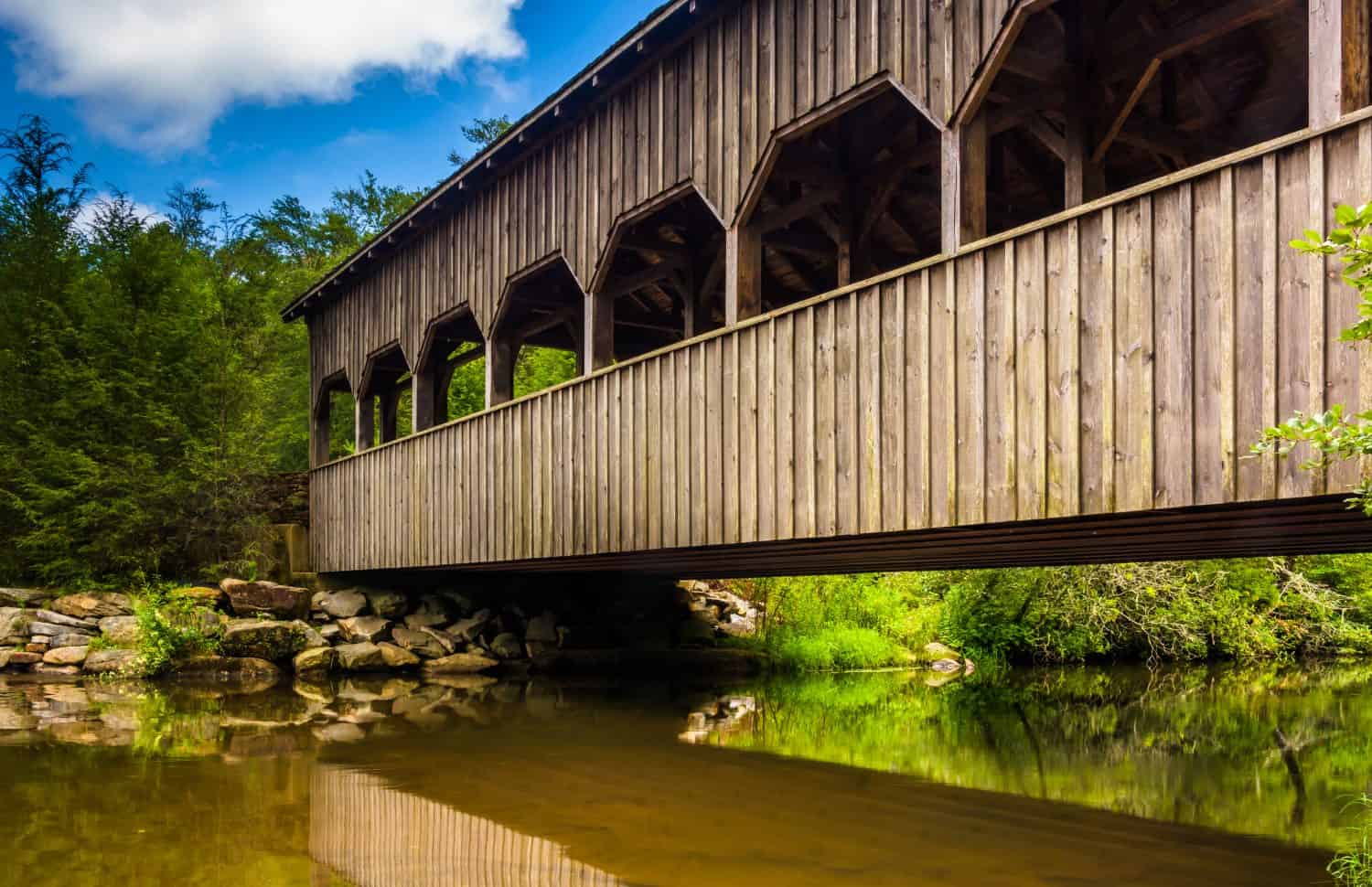Before the time of modern transportation, covered bridges dotted the landscape in our country, but sadly, not many still exist in the United States. Covered bridges intrigue us with their nostalgic, old Americana-style and serve as a rustic reminder of days gone by.
Travelers looking for man-made beauty often visit covered bridges, especially in North Carolina. While some of these bridges are icons or on historical registries, others are more recently constructed. If you love covered bridges, then this is the state to visit.
North Carolina has eight majestic bridges that are stunningly picturesque. Nestled within the natural scenery, these eight majestic bridges are a photographer’s dream.
Old Gilliam Mill Park Covered Bridge – Sanford
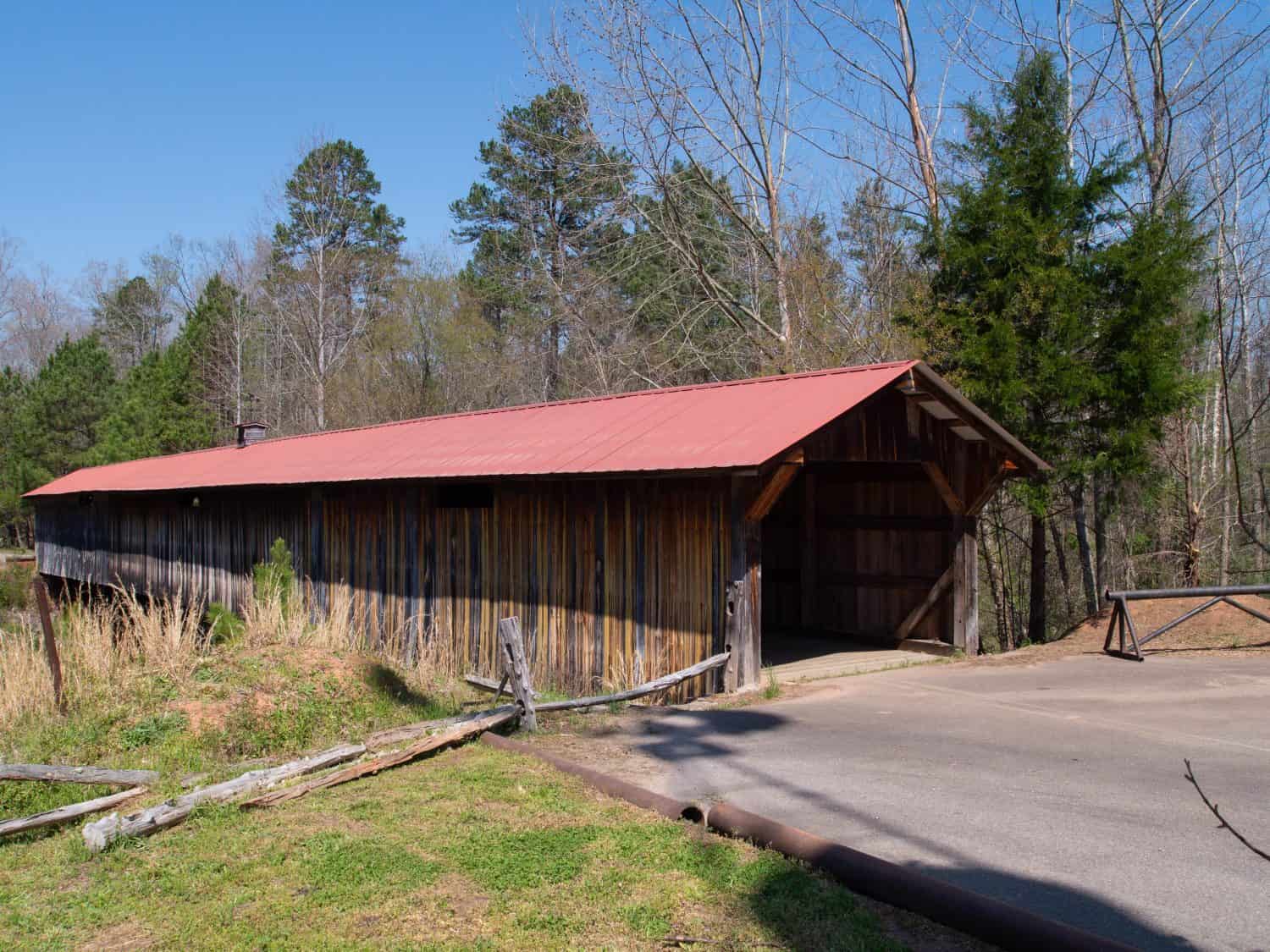
The longest covered bridge in North Carolina stretches out over 140 feet.
©Andy Fogelsonger/Shutterstock.com
If you travel NC-42 into Sanford, an unexpected, rustic site will greet you: the Old Gilliam Mill Park Covered Bridge. It runs parallel to a modern concrete bridge that spans the same rushing river. Located across from an old mill and mill pond, this bridge stretches over 140 feet, making it the longest covered bridge in the state.
The Gilliam family purchased the bridge and mill in the 1890s, and the family ran the mill for many years. A flood in 1928 washed away the mill, but in the 1970s, several locals worked weekends to rebuild the historic mill. Walking across this bridge will transport you to a different time. Stepping into the historic Ole Gilliam Mill Park, you can visit the restored mill and watch pottery being made in old-world brick kilns.
The bridge and mill are part of a private park that is free to visit and popular with the locals. However, this bridge is open only once a year for visitors to cross.
Bunker Hill Covered Bridge – Claremont
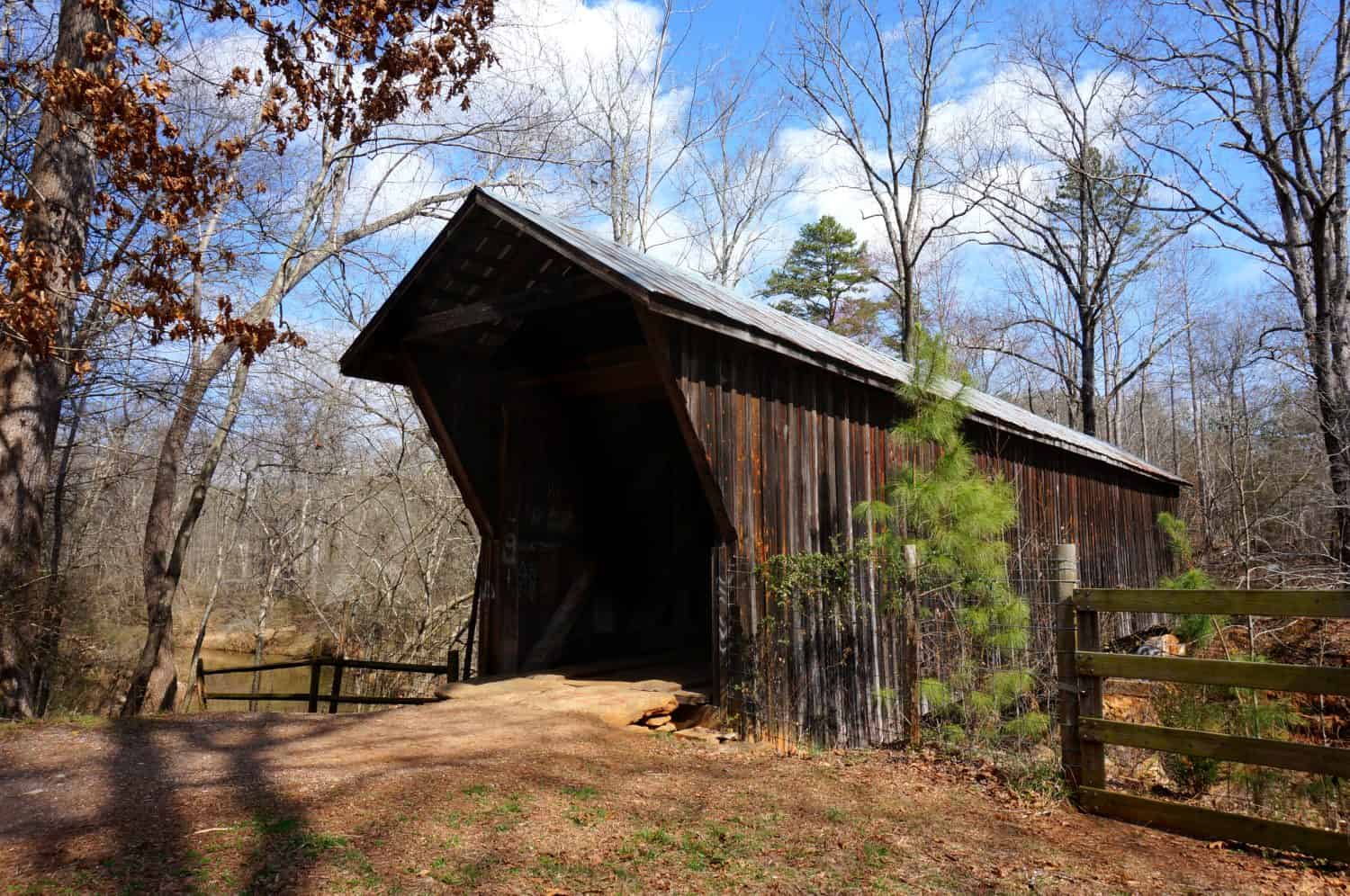
Bunker Hill can be found near Claremont.
©Gingo Scott/Shutterstock.com
One of only two original covered bridges in North Carolina, Bunker Hill is a National Civil Engineering Landmark and was originally an open span bridge. Construction for this bridge began in 1894 to give access to cross Lyle Creek. This bridge might be the only example left of a wooden bridge in the Improved Lattice Truss design, which uses a system of braces and counterbraces arranged at equal angles in opposite directions.
Covered bridges protected the wood from the elements, so in 1900, builders added a roof, and in 1921, a tin roof replaced the wooden shingles. The Bolick family donated this bridge to the Catawba County Historical Association, who restored it in 1994.
Pisgah Covered Bridge – Asheboro

The Pisgah Covered Bridge is a favorite spot for hikers in the Uwharrie National Forest.
©Andy Fogelsonger/Shutterstock.com
The other original covered bridge spans the Little River in the Uwharrie National Forest. This covered bridge is designated as a local and federal historical landmark. Built in 1911, its construction cost only $40 for this one-lane bridge. Walking over this bridge, one can connect back to a time when horse and wagon were the common means of transportation.
Today, the Pisgah Covered Bridge is open to the public for walking and hiking, leading hikers deeper into the Uwharrie National Forest. During a flood in 2003, the bridge floated off its foundation of stone pillars and was washed away. Local volunteers gathered 90 percent of its original components and builders rebuilt the bridge the next year. Visitors can see the bridge daily, though it is open only from dawn to dusk.
Kimesville Covered Bridge – Liberty
Along with Pisgah, the Kimesville Covered Bridge dots the landscape in Randolph County. Because this bridge is located on private property, it is inaccessible to the public. However, one can still see it from the road, and from a small pull-off area near the bridge, visitors can photograph the bridge. Not much of its history is known, but originally, this bridge was located on Layton Road, then moved to its present location of Humble Road. Today, it is still in good condition.
Gaddy Covered Bridge – Mt. Gilead
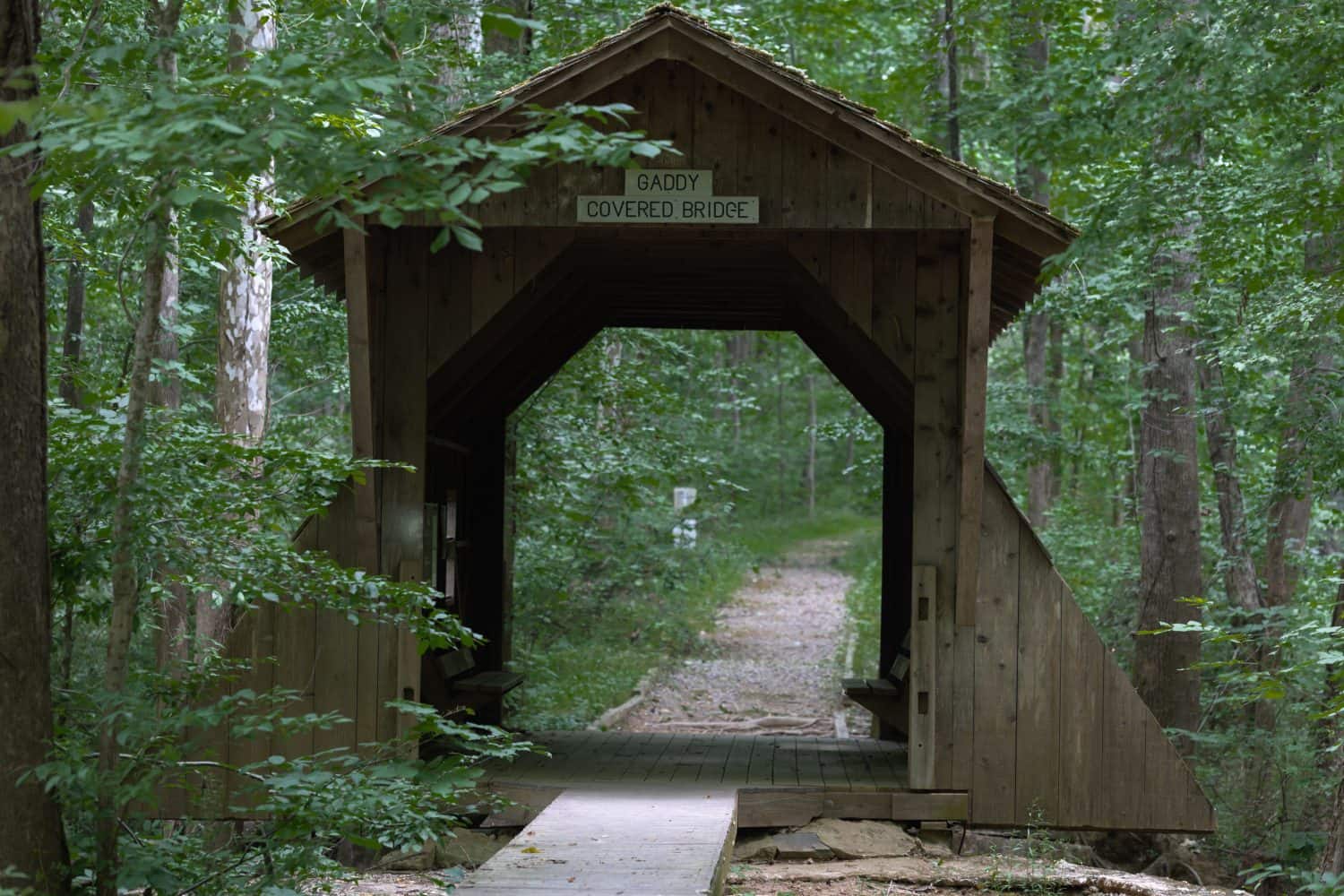
The Gaddy Covered Bridge is a treasure found near Mt. Gilead.
©J K Laws/Shutterstock.com
The Pee Dee National Wildlife Refuges holds a lesser-known bridge, the Gaddy. This rustic, wooden bridge is a hidden gem in the Piedmont region of North Carolina. This treasure is named for the Gaddy family, large contributors to the wildlife refuge.
Offering a stunning view of the Pee Dee River, this bridge has benches inside for resting and windows to view the wilderness surrounding it. Walkers and hikers who follow the Gaddy Covered Bridge Trail will easily find this bridge. The dirt-and-gravel trail is an easy walk, and hikers can explore the area without running into many people.
High Falls Covered Bridge – DuPont State Forest

Hikers can enjoy High Falls Covered Bridge at the top of High Falls waterfall in Dupont State Forest.
©Edd Lange/Shutterstock.com
Near Brevard, North Carolina, this covered bridge sits at the top of a 150-foot waterfall. An easy hike, the High Falls covered bridge is just a half mile from the High Falls Access Area. Though the bridge is wide enough, it is not accessible by car.
In the late 1990s, this area became state land, which protected three waterfalls: Triple Falls, High Falls, and Hooker Falls. Builders constructed this bridge above High Falls on the Little River. Watching the 150-foot waterfall spilling down a granite rock face, visitors will be glad they made the hike.
Will Henry Stevens Covered Bridge – Highlands
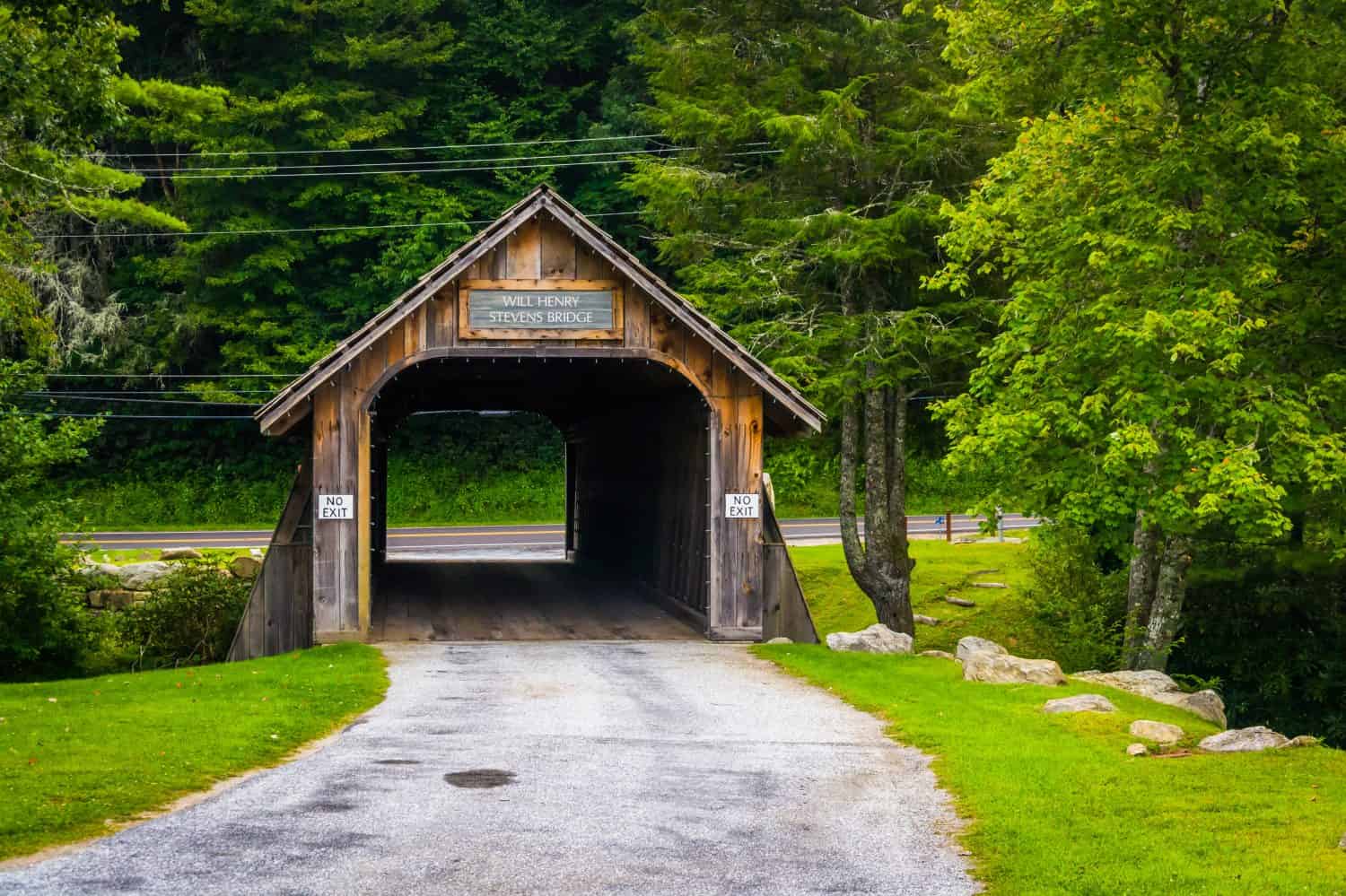
This covered bridge, originally from New Hampshire, was reassembled in North Carolina.
©Jon Bilous/Shutterstock.com
As wooden covered bridges began to disappear in the United States, Arnold M. Graton purchased the Bagley Bridge, one of New Hampshire’s oldest covered bridges, and placed it in storage. Forty years later, Graton had it transported to the Bascom Center for the Visual Arts in North Carolina. Here, he reassembled this white pine, lattice style bridge to create an entrance to the arts center.
60% of the materials had to be replaced with timbers that were naturally dried. Over 1100 tree nails (wooden nail-like fasteners), dowels, and trunnels rejoined the pieces. Completed in 2009, visitors can enjoy the marvel of this 200-year-old structure.
Old Salem Heritage Bridge – Winston Salem

The Old Salem Heritage Bridge connects visitors to the Old Salem Village.
©Sylvia Hill/Shutterstock.com
Made from southern yellow pine trees, builders designed and constructed this timber-frame bridge in 1998 to mimic historic bridges from the 19th century. Located in the Old Salem Museums and Gardens, this bridge serves as a gateway connecting the visitors center with the Old Salem Moravian village. Designer David Fischetti constructed the bridge to reflect the old style of the community that had settled there in 1766. During the holidays, Moravian stars hang from the ceiling. Today, it creates a magical effect after dusk and has become a favorite place to take holiday pictures every year.
Summary of 8 Majestic Covered Bridges in North Carolina
| Covered Bridge | Location in North Carolina |
|---|---|
| Old Gillam Mill Park | Sanford |
| Bunker Hill | Claremont |
| Pisgah | Asheboro |
| Kimesville | Liberty |
| Gaddy | Mt. Gilead |
| High Falls | DuPont State Forest |
| Will Henry Stevens | Highlands |
| Old Salem Heritage | Winston-Salem |
At the beginning of the 20th century, nearly 12,000 wooden covered bridges existed in America. As the use of steel in bridge construction became popular, these wooden bridges began to disappear. Today, we have only 800 left.
Luckily, you can still see some of these historic bridges in North Carolina. Others have been newly-constructed to remind us what these bridges were like, in a time when walking and horse and buggy were the main modes of transportation. And there’s just something about a covered bridge that is nostalgic and feels very Americana.
Thank you for reading! Have some feedback for us? Contact the AZ Animals editorial team.

